Input interpretation

O_2 oxygen + NH_2NH_2 diazane ⟶ H_2O water + N_2 nitrogen
Balanced equation
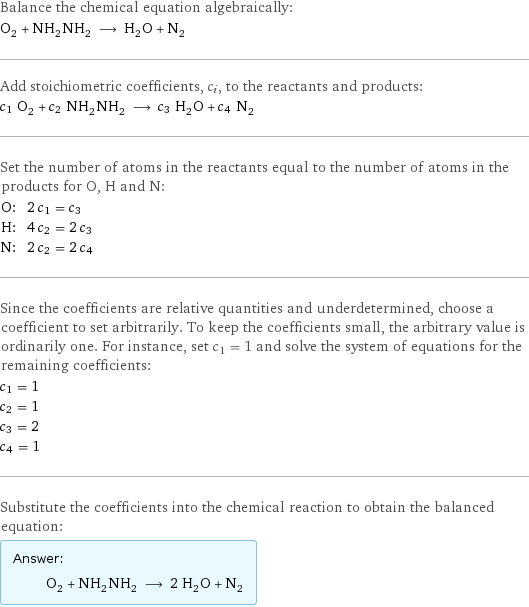
Balance the chemical equation algebraically: O_2 + NH_2NH_2 ⟶ H_2O + N_2 Add stoichiometric coefficients, c_i, to the reactants and products: c_1 O_2 + c_2 NH_2NH_2 ⟶ c_3 H_2O + c_4 N_2 Set the number of atoms in the reactants equal to the number of atoms in the products for O, H and N: O: | 2 c_1 = c_3 H: | 4 c_2 = 2 c_3 N: | 2 c_2 = 2 c_4 Since the coefficients are relative quantities and underdetermined, choose a coefficient to set arbitrarily. To keep the coefficients small, the arbitrary value is ordinarily one. For instance, set c_1 = 1 and solve the system of equations for the remaining coefficients: c_1 = 1 c_2 = 1 c_3 = 2 c_4 = 1 Substitute the coefficients into the chemical reaction to obtain the balanced equation: Answer: | | O_2 + NH_2NH_2 ⟶ 2 H_2O + N_2
Structures

+ ⟶ +
Names

oxygen + diazane ⟶ water + nitrogen
Reaction thermodynamics
Enthalpy
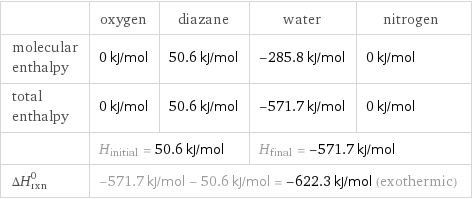
| oxygen | diazane | water | nitrogen molecular enthalpy | 0 kJ/mol | 50.6 kJ/mol | -285.8 kJ/mol | 0 kJ/mol total enthalpy | 0 kJ/mol | 50.6 kJ/mol | -571.7 kJ/mol | 0 kJ/mol | H_initial = 50.6 kJ/mol | | H_final = -571.7 kJ/mol | ΔH_rxn^0 | -571.7 kJ/mol - 50.6 kJ/mol = -622.3 kJ/mol (exothermic) | | |
Gibbs free energy
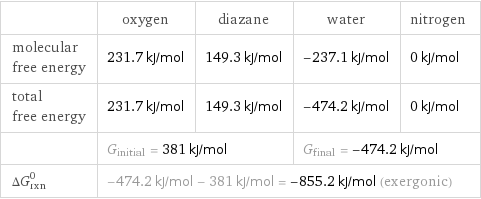
| oxygen | diazane | water | nitrogen molecular free energy | 231.7 kJ/mol | 149.3 kJ/mol | -237.1 kJ/mol | 0 kJ/mol total free energy | 231.7 kJ/mol | 149.3 kJ/mol | -474.2 kJ/mol | 0 kJ/mol | G_initial = 381 kJ/mol | | G_final = -474.2 kJ/mol | ΔG_rxn^0 | -474.2 kJ/mol - 381 kJ/mol = -855.2 kJ/mol (exergonic) | | |
Entropy
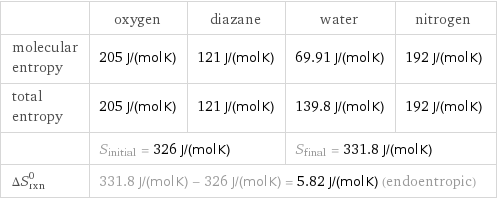
| oxygen | diazane | water | nitrogen molecular entropy | 205 J/(mol K) | 121 J/(mol K) | 69.91 J/(mol K) | 192 J/(mol K) total entropy | 205 J/(mol K) | 121 J/(mol K) | 139.8 J/(mol K) | 192 J/(mol K) | S_initial = 326 J/(mol K) | | S_final = 331.8 J/(mol K) | ΔS_rxn^0 | 331.8 J/(mol K) - 326 J/(mol K) = 5.82 J/(mol K) (endoentropic) | | |
Equilibrium constant
![Construct the equilibrium constant, K, expression for: O_2 + NH_2NH_2 ⟶ H_2O + N_2 Plan: • Balance the chemical equation. • Determine the stoichiometric numbers. • Assemble the activity expression for each chemical species. • Use the activity expressions to build the equilibrium constant expression. Write the balanced chemical equation: O_2 + NH_2NH_2 ⟶ 2 H_2O + N_2 Assign stoichiometric numbers, ν_i, using the stoichiometric coefficients, c_i, from the balanced chemical equation in the following manner: ν_i = -c_i for reactants and ν_i = c_i for products: chemical species | c_i | ν_i O_2 | 1 | -1 NH_2NH_2 | 1 | -1 H_2O | 2 | 2 N_2 | 1 | 1 Assemble the activity expressions accounting for the state of matter and ν_i: chemical species | c_i | ν_i | activity expression O_2 | 1 | -1 | ([O2])^(-1) NH_2NH_2 | 1 | -1 | ([NH2NH2])^(-1) H_2O | 2 | 2 | ([H2O])^2 N_2 | 1 | 1 | [N2] The equilibrium constant symbol in the concentration basis is: K_c Mulitply the activity expressions to arrive at the K_c expression: Answer: | | K_c = ([O2])^(-1) ([NH2NH2])^(-1) ([H2O])^2 [N2] = (([H2O])^2 [N2])/([O2] [NH2NH2])](../image_source/4ccd8b42f99b4f44ea23764a7e8fe2f8.png)
Construct the equilibrium constant, K, expression for: O_2 + NH_2NH_2 ⟶ H_2O + N_2 Plan: • Balance the chemical equation. • Determine the stoichiometric numbers. • Assemble the activity expression for each chemical species. • Use the activity expressions to build the equilibrium constant expression. Write the balanced chemical equation: O_2 + NH_2NH_2 ⟶ 2 H_2O + N_2 Assign stoichiometric numbers, ν_i, using the stoichiometric coefficients, c_i, from the balanced chemical equation in the following manner: ν_i = -c_i for reactants and ν_i = c_i for products: chemical species | c_i | ν_i O_2 | 1 | -1 NH_2NH_2 | 1 | -1 H_2O | 2 | 2 N_2 | 1 | 1 Assemble the activity expressions accounting for the state of matter and ν_i: chemical species | c_i | ν_i | activity expression O_2 | 1 | -1 | ([O2])^(-1) NH_2NH_2 | 1 | -1 | ([NH2NH2])^(-1) H_2O | 2 | 2 | ([H2O])^2 N_2 | 1 | 1 | [N2] The equilibrium constant symbol in the concentration basis is: K_c Mulitply the activity expressions to arrive at the K_c expression: Answer: | | K_c = ([O2])^(-1) ([NH2NH2])^(-1) ([H2O])^2 [N2] = (([H2O])^2 [N2])/([O2] [NH2NH2])
Rate of reaction
![Construct the rate of reaction expression for: O_2 + NH_2NH_2 ⟶ H_2O + N_2 Plan: • Balance the chemical equation. • Determine the stoichiometric numbers. • Assemble the rate term for each chemical species. • Write the rate of reaction expression. Write the balanced chemical equation: O_2 + NH_2NH_2 ⟶ 2 H_2O + N_2 Assign stoichiometric numbers, ν_i, using the stoichiometric coefficients, c_i, from the balanced chemical equation in the following manner: ν_i = -c_i for reactants and ν_i = c_i for products: chemical species | c_i | ν_i O_2 | 1 | -1 NH_2NH_2 | 1 | -1 H_2O | 2 | 2 N_2 | 1 | 1 The rate term for each chemical species, B_i, is 1/ν_i(Δ[B_i])/(Δt) where [B_i] is the amount concentration and t is time: chemical species | c_i | ν_i | rate term O_2 | 1 | -1 | -(Δ[O2])/(Δt) NH_2NH_2 | 1 | -1 | -(Δ[NH2NH2])/(Δt) H_2O | 2 | 2 | 1/2 (Δ[H2O])/(Δt) N_2 | 1 | 1 | (Δ[N2])/(Δt) (for infinitesimal rate of change, replace Δ with d) Set the rate terms equal to each other to arrive at the rate expression: Answer: | | rate = -(Δ[O2])/(Δt) = -(Δ[NH2NH2])/(Δt) = 1/2 (Δ[H2O])/(Δt) = (Δ[N2])/(Δt) (assuming constant volume and no accumulation of intermediates or side products)](../image_source/64d4793a77a192fe4214f3eece3d156c.png)
Construct the rate of reaction expression for: O_2 + NH_2NH_2 ⟶ H_2O + N_2 Plan: • Balance the chemical equation. • Determine the stoichiometric numbers. • Assemble the rate term for each chemical species. • Write the rate of reaction expression. Write the balanced chemical equation: O_2 + NH_2NH_2 ⟶ 2 H_2O + N_2 Assign stoichiometric numbers, ν_i, using the stoichiometric coefficients, c_i, from the balanced chemical equation in the following manner: ν_i = -c_i for reactants and ν_i = c_i for products: chemical species | c_i | ν_i O_2 | 1 | -1 NH_2NH_2 | 1 | -1 H_2O | 2 | 2 N_2 | 1 | 1 The rate term for each chemical species, B_i, is 1/ν_i(Δ[B_i])/(Δt) where [B_i] is the amount concentration and t is time: chemical species | c_i | ν_i | rate term O_2 | 1 | -1 | -(Δ[O2])/(Δt) NH_2NH_2 | 1 | -1 | -(Δ[NH2NH2])/(Δt) H_2O | 2 | 2 | 1/2 (Δ[H2O])/(Δt) N_2 | 1 | 1 | (Δ[N2])/(Δt) (for infinitesimal rate of change, replace Δ with d) Set the rate terms equal to each other to arrive at the rate expression: Answer: | | rate = -(Δ[O2])/(Δt) = -(Δ[NH2NH2])/(Δt) = 1/2 (Δ[H2O])/(Δt) = (Δ[N2])/(Δt) (assuming constant volume and no accumulation of intermediates or side products)
Chemical names and formulas

| oxygen | diazane | water | nitrogen formula | O_2 | NH_2NH_2 | H_2O | N_2 Hill formula | O_2 | H_4N_2 | H_2O | N_2 name | oxygen | diazane | water | nitrogen IUPAC name | molecular oxygen | hydrazine | water | molecular nitrogen
Substance properties
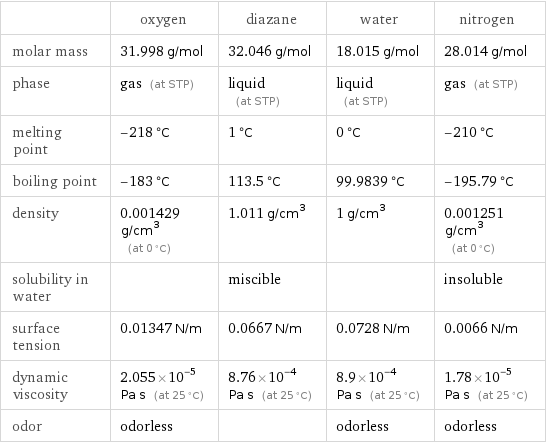
| oxygen | diazane | water | nitrogen molar mass | 31.998 g/mol | 32.046 g/mol | 18.015 g/mol | 28.014 g/mol phase | gas (at STP) | liquid (at STP) | liquid (at STP) | gas (at STP) melting point | -218 °C | 1 °C | 0 °C | -210 °C boiling point | -183 °C | 113.5 °C | 99.9839 °C | -195.79 °C density | 0.001429 g/cm^3 (at 0 °C) | 1.011 g/cm^3 | 1 g/cm^3 | 0.001251 g/cm^3 (at 0 °C) solubility in water | | miscible | | insoluble surface tension | 0.01347 N/m | 0.0667 N/m | 0.0728 N/m | 0.0066 N/m dynamic viscosity | 2.055×10^-5 Pa s (at 25 °C) | 8.76×10^-4 Pa s (at 25 °C) | 8.9×10^-4 Pa s (at 25 °C) | 1.78×10^-5 Pa s (at 25 °C) odor | odorless | | odorless | odorless
Units
